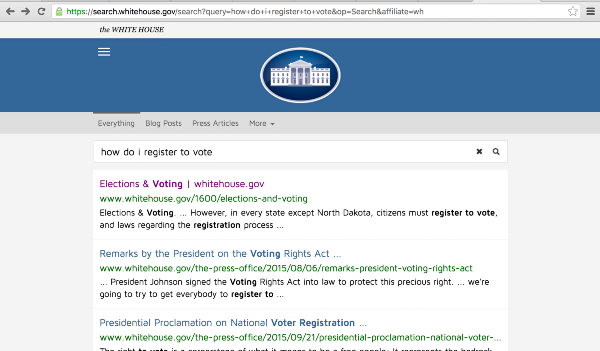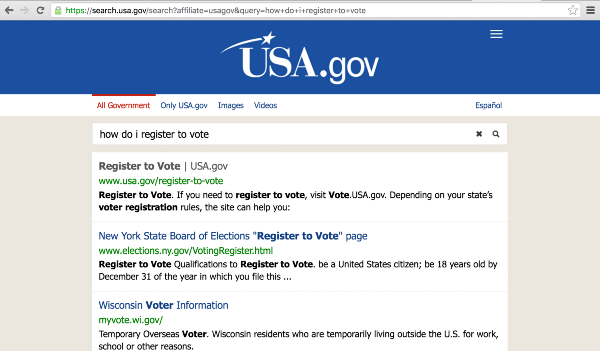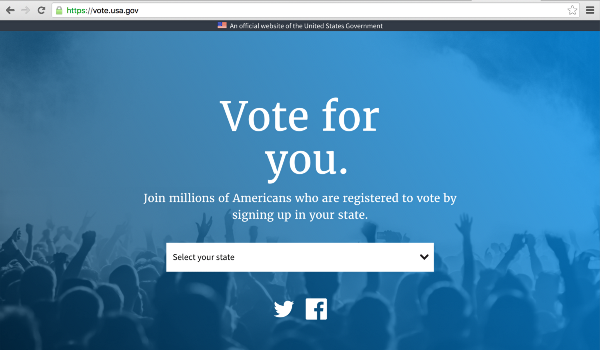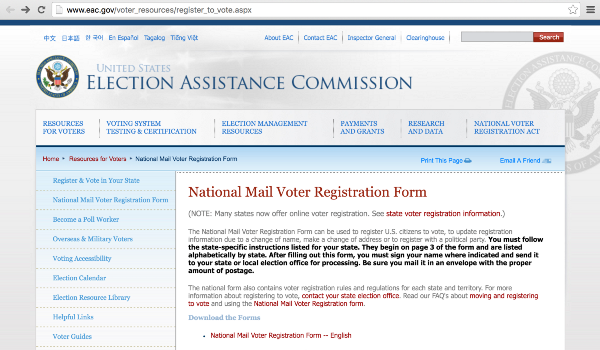
Since the release of the U.S. Digital Government Strategy in 2012, the Obama Administration has helped to fulfill the promise of a more open, responsive, and transparent government. The federal open data movement, catalogued at Data.gov, now boasts 86,403 datasets as released from 77 federal agencies and sub-agencies. That trove of information will help entrepreneurs, data scientists and policymakers find new ways to tackle our toughest social challenges.
But while researchers and entrepreneurs use open data to unlock the mysteries of the universe, the American public, at large, still struggles to use information about government services to make better decisions in their daily lives.
First, the network of government websites can be difficult to navigate, overwhelming users with too many choices. Second, even popular search engines like Google, Bing, or Yahoo can lead people to outdated or incorrect answers. And finally, as of 2016, a surprising number of Americans are stuck on the wrong side of the digital divide. According to Pew Research, approximately 33% of the population don’t have regular broadband access at home and 32% of adults don’t own a smartphone. 13% of American adults (approximately 40 million people) don’t use the Internet at all — that’s greater than entire population of California (est. 39 million. July 2015).
So how do we build a framework that gives people the right answers, at the right time, in the right format?
Introducing the ‘Conversation’ Framework
If we want to bridge the gap between the American public’s questions and the federal government’s answers, we have to meet people where they are, rather than asking them to come to proceed on government’s terms. That means starting from the premise that every google search, website click, or phone call to a government agency, begins with a question:
“How do I fight an eviction notice?”
“Where do I get help if my house floods from a natural disaster?”
“Is my child’s crib safe?”
“Can the government help my company find new customers abroad?”
“How do I register to vote?”
With that in mind, the process of shepherding an inquirer to an answer (i.e., (the user experience) can be thought of as a Conversation. In this context, a Conversation as a set of sequential questions defined by a government agency for a given prompt, that will guide the inquirer to an answer.
A great way to implement a Conversation framework would be with a semi-autonomous, conversational artificial intelligence bot. Using the technical parameters provided below, a conversational user interface (UI) bot, could operate on web, mobile, SMS, interactive voice response (IVR), messaging platforms (e.g., Slack, Skype), in addition to being integrated directly into Siri, Google Now, Cortana and other digital assistants.
That means we could go from this:
“How do I register to vote?” (as answered by four different government websites: Whitehouse.gov, USA.gov, VOTE.USA.GOV, EAC.gov)

screenshots from various government websites relating to voter registration (Whitehouse.gov)



to this:
“How do I register to vote?” (as answered by a conversational UI bot)
Benefits of a Conversational Framework:
Simplicity: If an inquirer poses a question in plain language, respond to him/her in plain language. Don’t make the inquirer decipher the answer. Each time we ask the inquirer to translate his or her question into a set of search terms, navigate a hierarchical website, or refer the inquirer to another resource, we make the process harder. And a more complex search means the user will be more likely to get sidetracked, give up, or, worse, get the wrong information. We can avoid (some) complexity by shifting the translation, research and navigation burden away to the government and away from the inquirer.
Interoperability: No one government agency has all the answers, so why not provide incentives for (or at least facilitate) information sharing? An important element of the Conversation class is the Callout, which enables a given Conversation to request information from a separate Conversation, even one created by a different government agency. The more Callout questions in a Conversation object, the more likely that the Conversation will help lead the inquirer to a definitive answer.
User-centered: The Conversation framework is designed to model natural (human) user interaction. Not only does the framework help the user find the answers he/she is looking for, but it aims to make the most efficient use of user input in doing so.
Platform-agnostic: The Conversation framework is not dependent on any particular data delivery application. You can run it on mobile, web, SMS, or even voice (via IVR). In fact, you could even map responses to Conversation questions directly to a RESTful API server.
Technical Parameters (a little more detail):
For you developers, computer scientists, and data scientists, we can actually build out a framework for Conversations by defining the following:
- the set of questions to be asked (the Conversation “class”)
- the procedures for asking those questions and getting responses from the user (Conversation “method”)
The Conversation Class and Methods:
Quick and Dirty Algorithm/Pseudocode for Conversation Framework:
Conclusion:
The Conversation framework is an idea in formation, and there are costs and considerations that will be explored in future posts about this project. That said, this is just one proposal out of many that government is considering in implementing a ‘customer-centric’ digital government strategy. Many within the USG digital coalition (U.S. Digital Service, Presidential Innovation Fellows, and 18F) are already working on solutions that are improving Americans’ access to information. H/T to Presidential Innovation Fellows,Patrick Koppula and Justin Koufopoulos for kickstarting this conversation!
But if this interests you, I’d love your feedback to see if this idea has legs. Please feel free to reach out to me at olivier.kamanda@pif.gov or follow me on twitter: @kamanda
Resources, References, and Additional Reading:
- Whitehouse.gov, Digital Government: Building a 21st Century Platform to Better Serve the American People — https://www.whitehouse.gov/sites/default/files/omb/egov/digital-government/digital-government-strategy.pdf
- USA.gov, Expectations and challenges: Informing the future of the Federal Front Door — https://labs.usa.gov/files/FFD_ResearchReport_0216.pdf
- Pew Research Center, Three Technology Revolutions — http://www.pewinternet.org/three-technology-revolutions/
- Tim O’Reilly, Government As a Platform — http://chimera.labs.oreilly.com/books/1234000000774/ch02.html
- Arnaud Sahuguet, Personal Views on the Future of Artificial Intelligence — https://medium.com/machine-intelligence-report/personal-views-on-the-future-of-artificial-intelligence-509c5db276fc#.wmmz1h4q9
- Henry Lieberman, User Interface Goals, AI Opportunities: — http://web.media.mit.edu/~lieber/Publications/UI-Goals-AI-Opportunities.pdf
